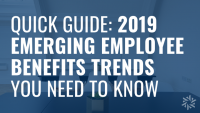Understanding PTO
Unlike traditional benefits, PTO is a bank of hours that employees can draw from for a number of reasons, including taking a vacation, taking care of a sick child, going to a doctor’s appointment or needing a personal day off from work. Employers either credit the employee’s bank every pay period with a specified amount of time that they can use, or credit the year’s worth of days at the start of the year. For instance, if the employer would offer 10 paid holidays, 2 weeks of vacation,2 personal days and 8 sick leave days, then the employee would bank 30 paid days off. Instead of the employer itemizing these days for a specific purpose, the employee uses the days at his/her discretion. (Many PTO plans keep paid holidays separate from the rest of the PTO.)
There are two ways to distribute PTO days. Some employers credit the full annual number of days to the employee’s account on January 1. Others prefer the days to accrue throughout the year and deposit days each pay period. Using the example above, if an employer pays bi-weekly, the employee would accrue 1.3 days every two weeks. Or, if the employer pays semi-monthly, the employee would accrue 1.25 days at each pay period.
PTO plans generally work best in an environment that is already flexible in nature and is open to modified work schedules, as PTO plans promote a work-life balance by allowing employees to determine when they should take time off, and what they should use it for.
Benefits of PTO
There are several benefits for both the employee and the employer of using a PTO plan versus the traditional vacation and sick benefits allotment.
The company appears more attractive to potential employees and current employees because they are allotted more days to take off. Since most employees do not use all of their sick days, they view the lump sum days as more vacation time.
Employees are treated as adults and are able to make their own decisions regarding vacation and personal time without having to provide an explanation to their employers.
Employees do not have to lie about being sick to take care of personal issues that they would rather not discuss with their employer.
Healthy employees don’t feel “penalized.”
Employers have more control over unscheduled absences that can become very costly.
Employers carry less financial liability to cover accrued vacation time (most PTO plans limit the number of days that can be carried over to the next year).
Administration of these plans is not as complex and does not require as much guidance.
Often times employers offer less PTO versus vacation and sick time which saves money as employees are actually in the office more (Instead of offering 10 vacation days and 8 sick days, the employer may choose to offer 15 PTO days).
Disadvantages of PTO
Unlike traditional employer-controlled time off packages, PTO plans are in the hands of the employee, which can present several downfalls.
Some employees take advantage of their freedom and are gone more frequently than they would if they had specific days for certain purposes. For instance, someone that would not normally use eight sick days because they are not ill for eight days in the year, would use all eight PTO days because they are available. This causes the employer to lose the money they would have saved had that employee not been “sick” for eight days.
Since many employees view PTO as a lump of vacation time, many come to work ill because they do not want to use that time to stay home and rest. Therefore, other employees get sick and production decreases.
When employees leave the company, employers are required to pay out PTO days because they are considered a vacation benefit, whereas sick days would not have been paid out under a traditional plan.
Upon implementing a PTO plan, long-time employees may receive a large monetary payout for all of their accrued vacation and sick time or they would bank a tremendous number of paid days off.
If employees use their PTO time early in the year, they have no safety net if they get sick later on.
PTO plans can breed resentment amongst employees, as some use them to care for sick children or elderly parents, whereas others without those responsibilities use them for recreation and vacation.
Often times employers offer less PTO versus vacation and sick time which can be seen as a negative for employees as well as recruitment of new employees, when totaling the sum of days off provided by other companies.
Recommendations for PTO
If your company is considering implementing a PTO plan, there are several considerations to take into account. First and most importantly, make sure this benefit option fits with your company environment and culture. If you are not open to flexible work schedules such as flex-time or flex-place arrangements, PTO plans may not be a good option either. In addition, it is best to establish clear directives for your employees before implementing the plan. For instance, you may require employees to give at least a three-day notice before using a PTO day unless he/she is sick or there is an emergency. With that, you must also define an emergency situation and stick to that definition. Does a sick child or a flat tire count as an emergency? What about a hangover? Or waking up on the wrong side of the bed? If the policy is straightforward and clearly outlined, employees will not feel apt to take advantage of this newfound freedom.
Also, simply because the employee controls when and why they take off work does not mean that you can not manage them while they are at work. Therefore, if they come in sick because they do not want to use PTO days, you can simply send them home. Those days are designed for fun times as well as illness, so they should be used as such. All in all, Paid Time Off is a viable option that should be considered, as it works well for many companies and can be a beneficial alternative to traditional vacation and sick time off.
How many PTO days is enough?
In a 2016 study conducted by the Society for Human Resource Management, the average number of paid leave days for full-time employees were as follows:
PTO – 18 days
Paid Vacation – 16 days
Paid Sick – 11 days
Paid Personal – 4 days
Designing a PTO Program: Checklist
The following factors are ones that should be considered when designing a PTO plan:
What types of absences will you include in the PTO bank?
How many PTO days will be available to employees? Will those days be determined by job level, seniority or another factor?
Will PTO replace all forms of paid absence or will you retain separate policies for typically unanticipated leaves, like bereavement or jury duty?
Will any of the PTO days be eligible to carry-over to the following year? If not, must the account be paid out at the end of the year?
How is payment calculated for unused PTO days? Will the employee get 100 percent of the cash value or a lesser percentage?
If the employee leaves the company, will the individual receive the value of their PTO account? Or will it only be paid out when the employee voluntarily resigns or retires?
How will the program be administered and coordinated with payroll?
How often will the program be reviewed, and by whom?
There are many factors to consider when deciding to update your time-off policies. First among them must be — what will the change do for employee morale? And, will you be able to position the change as a positive for your employees? If the answer to these questions is yes, then now may just be the right time to make a change.
Your Austin team can help you craft the policies for your employee handbook and employee communications. Simply reach out to your dedicated Account Manager or contact us at service@austinbenefits.com.



